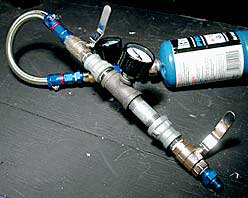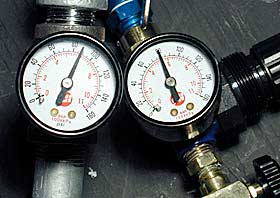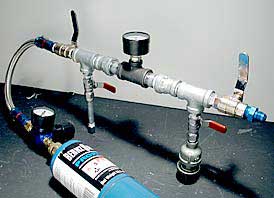|
Fuel Tool Live still has a few rough edges. We are working on this to bring FT Live up to the standards of the Excel version.
|
|
|
OnLine Measurement Conversions
http://www.onlineconversion.com
|
|
|
Calculate Your Atmospheric Pressure (PSIA)
http://www.turblex.com/altitude/index.cfm
|
|
|
Propane and MAPP - MSDS
http://www.bernzomatic.com/littr.htm
|
|
Plumbing pipe is notorious for confusing naming conventions. A 3/8" plumbing nipple from Schlomo Depot actually has an inside diameter of almost half an inch. Fuel Tool uses the figures shown in the yellow column. |
|
||||||||||||||||||||||
|
The lower and upper flammable limits of propane and MAPP gas are shown to the right. |
|
|||||||||||||
Fuel Tool was used to calculate the proper meter volume for our L1 launcher. Originally the L1 had a standard 3/8"x6" meter pipe and no regulator. This worked perfectly for the chamber's 2600cc volume and average propane pressure of 90 PSI. During testing , a problem with this setup became evident. The propane was having a hard time keeping 90 PSI because after a few shots, the bottle would start getting cold. This required a larger meter that could run at lower, controllable pressures, and a regulator of course.
The large meters were fitted with a pressure gauge and it was found that it takes a couple seconds for the pressure to equalize between the supply and meter pipe. These funky shaped meters were difficult to measure using formulas so they were measured with water. Fluid volume measurement provides a high degree of accuracy as it takes into consideration all the area between valves, fittings, etc. The gauge was removed and water added in a way that vented any air pockets.
The pressure regulator proved to be the key element. A mid range base pressure of 37 PSI was established with the choice of meter volume. This combination gives a calculated 4% propane to air ratio by volume. The regulator is used to accurately adjust the mix up or down. When using Fuel Tool, we kept an eye on the required 41ml meter volume then adjusted the pressure until the desired 4% mix was reached. It took about 10 seconds and let us preflight the designs.
|

|
||||||||||||||||||||||||||||||||
|

|
||||||||||||||||||||||||||||||||
|
Comments: A wadding made from a cotton t-shirt was used for these tests. The pressure gauges were switched and it was determined that one or both of them are off. Tech rep from manufacturer says, " those things all read different". Gauges were compared against a calibrated gauge which gave a reading right in the middle of my two gauges. Both dials will be opened and recalibrated. It's interesting to note the LFL and UFL are different from the quoted limits of 2.1-9.5%. This large meter/low pressure thing looks promising. Power and distance tests next. |
|||||||||||||||||||||||||||||||||||||||||||||||||||||||
|
UPDATE 11/3: Just finished rifled barrel tests at 50' and 150'. 37 PSI kicks ass, strong every shot. It was also easy to maintain a constant pressure, even with a half empty lp bottle. 37 PSI gives a calculated 4% propane on a 41ml meter. Of note, during the recent tests at 4% mix, the was no noticable muzzle flame at all, as opposed to the tests on the chart above.?. No flame may be a result of using potatoes instead of t-shirt wadding. |
